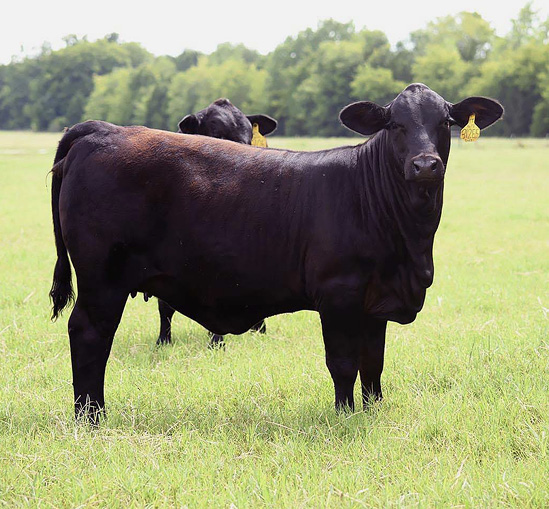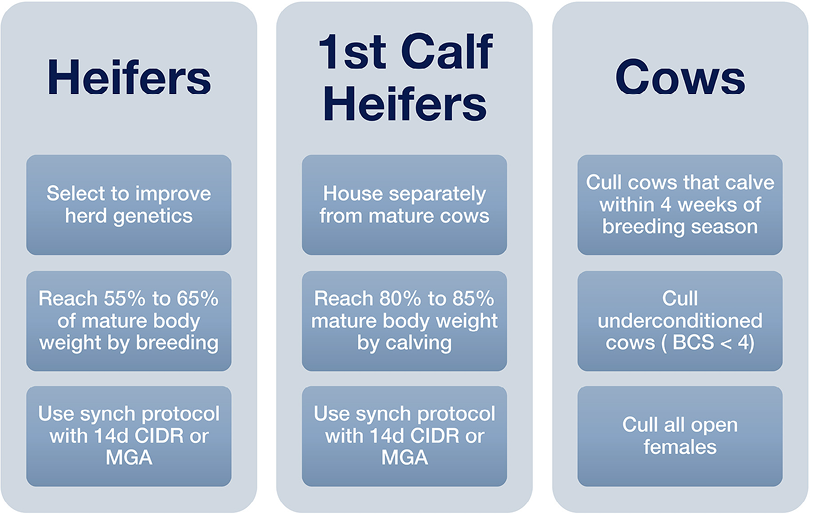Reproductive Management for Bos indicus-Influenced Cows

Bos indicus-influenced cattle breeds, such as Brangus, Beefmaster, Braford, Simbrah, and Brahman, are popular in Southeastern cattle operations. These cattle are more heat tolerant, more parasite resistant, and generally hardier than their Bos taurus counterparts. Moreover, these cattle are highly maternal and produce a calf crop with potential in both the commercial and seedstock sectors of the industry. However, reproductive management of Bos indicus-influenced cattle is quite different from Bos taurus cattle. Reproductive failure in indicus-influenced cattle operations is often due to improper management techniques. The objective of this publication is to provide tangible management practices for heifers, first-calf heifers, and cows to improve reproductive success within an indicus-influenced operation.
Heifer Management
Ensuring Genetic Potential and Improvement
The first consideration in heifer management is ensuring that replacement heifers are genetically improving the herd. Genetic improvement can be achieved by retaining heifers from your own operation or purchasing genetically verified replacement heifers. However, you can follow some general selection and management guidelines to ensure reproductive success throughout their lives. Utilizing expected progeny differences (EPDs) to gauge sire contributions to female offspring is beneficial; specifically, ensuring that sires utilized for replacement heifers have optimal maternal characteristics that include these characteristics:
- Increased scrotal circumference (correlated to early puberty achievement in daughters).
- A desirable maternal milk EPD.
- Increased calving ease maternal EPD.
- Increased EPDs for heifer pregnancy traits.
Higher values in these traits from sire EPDs indicate that a bull’s daughters will make good replacement heifers. Finally, body condition, frame size, disposition, udder, conformation, and soundness of a heifer should be considered when choosing to retain or purchase the heifer. Lastly, heifers born earlier in the calving season are more likely to reach puberty earlier, wean heavier calves, and have high retention rates in the herd (Cushman et al., 2013). Therefore, we recommend the use of heifers with optimal genetics that are born early in the calving season and possess characteristics that perform well in your operation.
Breed to Calve by 24 Months of Age
Maximum lifetime productivity for a heifer is achieved when heifers calve by 24 months of age (Nunez-Dominguez et al., 1991). When heifers do not reach this goal, it is often attributed to failure of the heifer to achieve puberty by the first breeding season. Two major management practices can be utilized to increase achievement of puberty in heifers.
Nutritional Plane
Heifers should be 55 percent to 65 percent of their mature body weight by breeding season (Funston et al., 2012). Mature body weight can be calculated based on the average weight of cows over 5 years old on the current operation. Then, decide the percentage goal for your heifers (between 55 percent and 65 percent) and breeding dates. When possible, breeding dates for heifers should be several weeks before breeding mature cows. Use the weaning weights and desired breeding weight to calculate the average daily gain needed. Once you determine the rate of gain, you should alter diets to meet these goals.
Example: The average mature cow weight on the operation is 1,300 pounds, breeding season starts in 228 days, and heifers at weaning averaged 430 pounds. You decided to feed your heifers to 60 percent of mature body weight by weaning. Using these numbers in the equation below will result in body weight gain needed per day.
(1,300 × 0.6) = 780-pound breeding weight – 430-pound weaning weight = 350 pounds to gain / 228 days = 1.53 pounds/day
Jumpstart via Estrus Synchronization
Utilizing an estrus synchronization protocol with a sustained use of progesterone before the breeding season advances the onset of puberty within heifers. There are two FDA-approved progesterone supplements:
- Controlled internal drug release devices (CIDR, approved in cows and heifers); and
- Melengestrol acetate (MGA, approved in heifers only).
A comprehensive list of current recommended estrus synchronization protocols utilizing progesterone (CIDR/MGA) can be found on the Beef Reproductive Task Force website (https://beefrepro.org/). This reference is a valuable tool to check annually to determine if current estrus synchronization protocols should be updated. There are also Bos Indicus-specific protocols that work well in Indicus-influenced cattle, but the priority in these animals is using protocols that jumpstart estrus.
Regardless of the type of protocol used (heat detection, timed artificial insemination [TAI], or fixed timed artificial insemination [FTAI]), it is strongly recommended to choose a “long-term” protocol that uses 14-day progesterone (CIDR/MGA) to increase puberty achievement in heifers (Perry and Geary, 2004). When choosing a protocol, it is important to backdate from the desired breeding date. Moreover, CIDR usage is recommended over MGA use, especially if there is not adequate bunk space (2.5 feet per head) to ensure all heifers are getting the correct dose. If heifers are kept in a feedlot setting, consider cutting the CIDR strings shorter to prevent CIDR loss over the 14 days. Following these recommended protocols will increase puberty achievement resulting in higher conception rates to first artificial insemination translating to increased chance of reproductive success as first calf heifers.
First-Calf Heifer Management
Management of first-calf heifers is crucial to retaining cows within the herd. The most advantageous management strategy is increasing the time between calving and rebreeding. This is achieved by applying the previously mentioned heifer management strategy, which results in early conception at first breeding. During the interval between calving and second breeding, you should monitor the heifer’s body condition, can alter the nutrition plane, and can use a longer estrus synchronization protocol to jumpstart estrus.
Achieve 80 to 85 percent of Mature Body Weight by Calving
These animals have the highest nutrient demands within the herd, so they should be housed separately from mature cows and be fed to achieve 80 to 85 percent of mature body weight by calving. Weight gain should be monitored by body condition scoring (BCS) and weighing of first-calf heifers during gestation and after calving. Recommended BCS at calving is a minimum of 6. Again, these heifers should not be mixed with the mature cows until after the second breeding season and pregnancy confirmation. Meeting their nutritional requirements will increase the number of heifers that are cycling by the start of the breeding season, which increases their likelihood of pregnancy success.
Increase Interval from Calving to Breeding Season
By retaining only heifers that achieved pregnancy early in the previous breeding season, there is an increased amount of time between calving and the second breeding season. This longer window creates several advantages:
- Increased uterine involution.
- Time to increase body condition.
- Time for longer estrus synchronization protocols to be used.
- Decrease number of anestrous animals at start of breeding season.
We strongly recommend the use of a 14d CIDR protocol on first-calf heifers to increase cyclicity while providing a high plane of nutrition (Grings and Wright, 2020). However, this goal can only be achieved if your first-calf heifers are among the first of the herd to calve; consider this when choosing breeding dates for heifers.
Cow and General Management
After the first two breeding seasons, mature cows require less intensive management, but culling decisions to achieve optimal reproductive performance within a herd is important. The ultimate production goal should be to increase females bred on first service leading to early calving dates that translates to heavier weaning weights and increased dam reproductive success (Patterson et al., 2003).
Cull Late Calvers
Cows that calve late within the season (less than 4 weeks before breeding season) are highly unlikely to become pregnant on the first service. This will lead to a perpetually late-calving cow that will eventually not become pregnant during the breeding season. Culling cows that calve late and replacing them with early-bred heifers will shorten the breeding season and tighten the calving interval. This production technique leads to increased dam conception rates at the following breeding and increased weaning weights.
Cull Underconditioned Cows
Cows that are underconditioned (BCS < 4) at calving are unlikely to gain weight during lactation, have decreased chance of rebreeding, wean lighter calves, and have increased nutritional costs. Therefore, these cows typically do not produce well enough to justify retaining them in the herd. Replacing these animals with high-quality heifers will ultimately yield better economic outcomes.
Cull Open Females
Finally, any female (heifer, first-calf heifer, or cow) that did not become pregnant within a 60- to 90-day breeding season should be culled. Improving the overall reproductive success of the herd is not possible by retaining females that fail to achieve the standard, thus it is necessary to remove these females from your operation to limit economic loss.
Conclusions
The improvement of reproductive success within indicus-influenced cattle is heavily reliant on management techniques. Among the most important is nutritional management, utilization of proper estrus synchronization protocols, and stringent culling. The constant introduction of new genetics into the herd, combined with proper management techniques, will result in a promising calf crop that will yield high economic outputs in both commercial and seedstock operations. Ultimately, large adaption of these techniques should lead to overall improvement of indicus-influenced cattle’s reproductive success in the Southeast.

References
Beef Reproductive Task Force. 2022. https://beefrepro.org/
Cushman, R. A., L. K. Kill, R. N. Funston, E. M Mousel, and G. A. Perry. 2013. Heifer calving date positively influences calf weaning weights through six parturitions. J. Anim. Sci. 91: 4486-91
Funston, R. N., J. L. Martin, D. M. Larson, and A. J. Roberts. 2012. Nutritional aspects of developing replacement heifers. J. Anim. Sci. 90:1166-71
Grings, E. E., and C.L. Wright. 2020. Selection and management of heifers and young cows. In: Beef: Best Management Practices for Cow-Calf Production. SDSU Extension, South Dakota Board of Regents.
Nunez-Dominguez, R. L., L. V. Cundiff, G. E. Dickerson, K. E. Gregory, and R. M. Koch. 1991. Lifetime production of beef heifers calving first at two vs. three years of age. J. Anim. Sci. 69:3467-79
Patterson, D. J., F. N. Kojima, and M. F. Smith. 2003. A review of methods to synchronize estrus in replacement beef heifers and postpartum cows. J. Anim. Sci. 81(14):166-77
Perry, G. A., and T. W. Geary. 2004. Ability of CIDRs or Melengestrol Acetate to initiate estrous cycles in early postpartum beef cows. South Dakota Beef Reports, Paper 16.
The information given here is for educational purposes only. References to commercial products, trade names, or suppliers are made with the understanding that no endorsement is implied and that no discrimination against other products or suppliers is intended.
Publication 3888 (POD-04-23)
By Riley Messman, PhD, Graduate Assistant; Brandi Karisch, PhD, Associate Extension/Research Professor; Clay Cavinder, PhD, Professor; and Rhonda Vann, PhD, Research Professor, Department of Animal and Dairy Sciences.
The Mississippi State University Extension Service is working to ensure all web content is accessible to all users. If you need assistance accessing any of our content, please email the webteam or call 662-325-2262.





